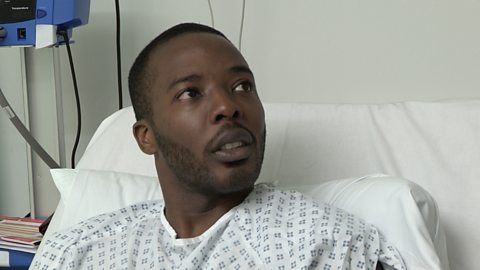Sharing ideas and techniques
Watch the video to find out more.
Speaker 1: So, one of the things we are going to talk about today is, when we are performing the needlestick test and we're taking blood from clients.
This can be quite a nerve-racking experience.
Is that something that you've been experiencing?
Speaker 2: Yeah, I agree. Generally people get scared when they hear about needles and blood.
Speaker 3: They want to know where the blood's going, what we're going to do with it.
Speaker 4: Yeah. Sometimes, you'll say the word 'needles', it scares them, and they could freak out completely.
Speaker 1: (TO AUDIENCE) The point of having these meetings is that it enables people to increase their confidence in maybe dealing with challenging or difficult situations when they're with clients.
(TO OTHER PEOPLE) What sort of things are you using, techniques to calm people down and reassure people?
Speaker 2: Well, it is best to create a general conversation, to talk about how their day was, any plans for the weekend.
Speaker 3: Reassuring them as well.
Yeah, just letting them know that everything will be fine.
It's a quick process and it's for their benefit.
Speaker 2: It is also best to show the equipment that we will be using to perform the test.
Speaker 3: Yeah.
Speaker 1: That sounds like you're using some really good techniques there.
So we're using distraction, we're reassuring them through the process, and explaining the things you'll be doing when taking the test.
OK, brilliant.
Making contributions to a discussion
Test your knowledge with this activity.
Using techniques
Watch the video to find out more.
Speaker 1: OK, John. So we have just finished the questionnaire about your lifestyle.
We are going to move to your blood test now.
Speaker 2: Blood test? I don't like the sound of that.
Speaker 1: Don't worry. It is about your cholesterol.
I'm going to take a pinprick from your finger.
Speaker 2: OK. I'm a bit queasy actually.
I don't really like the sight of my own blood.
Speaker 1: Don't worry, John. I'm going to do it quickly and carefully.
OK?
Speaker 2: OK.
Speaker 1: So would you mind giving me one of your hands?
Speaker 2: OK, yeah, yeah.
Speaker 1: Alright, thank you. It's been hot today.
Speaker 2: Hot? Oh, yeah, it's really hot, yeah, yeah.
Speaker 1: How was your journey here?
Speaker 2: Err, well, you know.
I got on a packed, sweaty tube which was delayed so, you know.
Speaker 1: OK - ready now?
Speaker 2: Yeah.
Speaker 1: Here I go. OK, that's it. I'm taking the sample now.
You can squeeze it. Squeeze it and it's all done. How was it?
Speaker 2: Actually, it wasn't too bad.
Speaker 1: We'll put the sample here.
What would you say?
Test your knowledge with this activity.
Feeding back experiences
Watch the video to find out more.
Speaker 1: So, how have you found the last week?
Speaker 2: Well, from our last meeting, I took on the step-by-step method and I explained to the client what I was about to do and I found that it worked really well.
Speaker 1: Lenke?
Speaker 3: I had a very nervous client and he was scared of the needle, so I used the technique of distraction.
I mentioned the weather and then I also asked my client about his journey and it seemed to work very well.
Speaker 1: So it reassured him?
Speaker 3: Yes.
Speaker 4: At what point did you use this particular technique?
Speaker 3: Well, actually, I used the technique just before the finger prick, while I was cleaning the finger.
Speaker 1: Thank you for sharing. That's brilliant.
And all really useful as well, and things that we can all be adopting when we are working with clients.
Speaker 3: (TO AUDIENCE) I can share my experiences and get support from my colleagues or my manager, and also, it works the other way round that I can learn something new from my colleagues as well.
Managing ideas and suggestions
Test your knowledge with this activity.
More on Health and social care
Find out more by working through a topic
- count4 of 5

- count5 of 5
